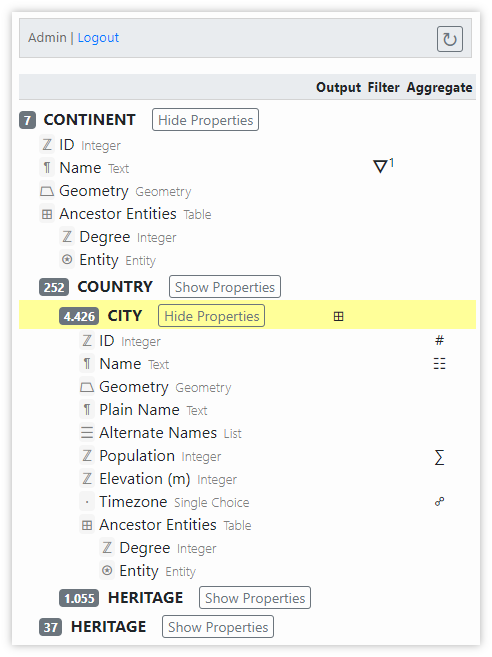-
Notifications
You must be signed in to change notification settings - Fork 2
Database Structure Pane

This pane contains two parts: a header and a tree representing the nested structure of entities in the database.
The header displays the name of the logged in user and a link to log out of the tool. The header also contains a button labeled with the symbol ↻. It can be used to refresh the database. The empty space in the header may display some some status text when working with the tool, particularly when lengthy processing is taking place. Most of the time it should however remain empty.
The main portion of the pane is occupied by a tree-like display of the structure of entities in the database. The nesting of entity types in the tree reflects the actual nesting of entities in the database.
Example: in the screenshot, we see that there are 529 entities of type ORTE in the database at top level. As child entities of these top-level ORTE, there are 529 FUNDSTELLE and 1 EINZELFUND. The FUNDSTELLE entities have a total of 223 SURVEYFLÄCHE child entities and 18,392 EINZELFUND child entities. The SURVEYFLÄCHE entities have 1,199 child entities of type SPUR.
By clicking the Show Properties button next to the entity type labels, the list of properties of the entity type fades in. Each property is listed with its label (i.e. ID, Name, Geometry, etc. in the screenshot) and its data type (e.g. Integer, Text, Geometry, etc.).
Some entity types may expose nested properties. These table properties (e.g. Fundstelle Statistik and Prospektionsfunde in the screenshot) have child properties, each reflecting a column of the table property.
The three columns Output, Filter, and Aggregate, display symbols for any row that is used in the Analysis Options, respectively.
Example: in the screenshot above, the analysis options specify to output a table (
⊞) of FUNDSTELLE entities. There is one filter (⛛) on each of the properties Geometry, Fundobjekte (in table property Prospektionsfunde), and Anzahl (also in table property Prospektionsfunde). The result table is grouped (☍) by values of property Fundobjekte in table Fundstelle Statistik. The result table also includes a count of FUNDSTELLE entities (#), a list of entity _Name_s (☷), the average of Dichte (Ar) (⌀), and the sum of Anzahl (∑) as aggregate properties.
The row in the tree above which the user hovers the mouse pointer is highlighted with yellow background.